矢量代数
人们通常在寻找某个地方时会问路。通常的答案是进入特定的一段距离。因此,可以得出结论,只有方向是不够的,在那个方向上要行驶的距离的大小也同样重要。用数学术语来说,关于方向和大小的信息通常通过向量来传达。向量在游戏设计和人工智能领域非常有用。让我们详细研究一下向量的概念。
向量简介
在物理和数学中,我们经常遇到几种类型的量。所有这些量都可以分为两大类——标量和向量。举个例子——一个人的身高和体重可以用一个数字来描述,比如 75 公斤或 150 厘米。这些量只有量级,它们不需要任何额外的信息。这样的量称为标量。现在,让我们考虑另一种情况,例如,足球队的教练想教他的守门员将球传给另一名球员,现在他必须描述他应该向哪个区域(方向)传球以及他的努力程度应该达到(幅度)。这个量需要大小和方向。这样的量称为向量。
A vector is a quantity which has a direction and a magnitude.
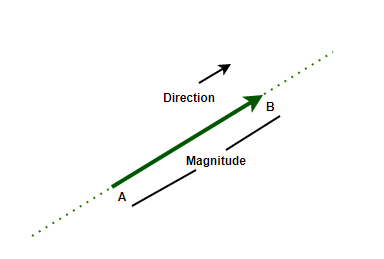
上图中,线的长度表示向量的大小,箭头指向它的方向。它基本上是一个有向线段 .它的起点A称为起点,终点B称为终点。
向量的类型
Vectors can be classified into different categories on the basis of their magnitude and direction:
- Zero Vector: A vector whose initial and terminal points coincide, is called a zero vector. It cannot be assigned any direction or magnitude.
- Unit Vector: A vector that has a unit magnitude. A unit vector in the direction of given vector
 is denoted by
is denoted by .
- Co-initial Vectors: The vectors which start from the same point are called co-initial vectors.
- Collinear Vectors: Two vectors are said to collinear if they are parallel to the same line, irrespective of their magnitudes and direction.
- Equal Vector: Two vectors are considered equal if they have the same direction and magnitude.
- Negative of a Vector: It is a vector whose magnitude is the same, but the direction is opposite to that of a vector.
向量的加法
一个向量可以认为是从 A 点到 B 点的位移。要了解向量的加法和减法的需要,请考虑一个示例。在图中,Laxmi 沿着图中所示的向量从 A 点到 B 点,然后到 C 点。现在,到达 C 点后,这个女孩的净位移是从 A 到 C,由向量给出
.
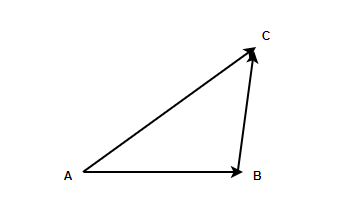
这可以用向量表示为,
=
这被称为向量加法的三角定律。一般来说,对于两个向量![]() 和
和![]() 它们的相加是为了使一个向量的初始点与另一个向量的端点重合。
它们的相加是为了使一个向量的初始点与另一个向量的端点重合。

在上图中,我们在 part(i) 中给出了两个向量 a 和 b,在 part(ii) 中,向量 b 在不改变其方向和大小的情况下移动,因此现在向量的初始点![]() 位于向量 a 的端点。在减法的情况下,向量b的方向是相反的,然后两个向量相加。
位于向量 a 的端点。在减法的情况下,向量b的方向是相反的,然后两个向量相加。
加法和差分具有几乎相似的概念和方法,只是在计算差分时,一个向量的方向是相反的。
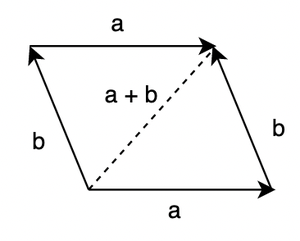
如果这两个向量表示为平行四边形的相邻边,则它们的大小和方向之和表示平行四边形的对角线。这被称为向量加法的平行四边形定律。
向量加法的性质
性质1:向量加法遵循交换性质。对于两个向量![]() 和
和![]() .
.
属性2:三个向量的向量加法遵循关联属性。
向量与标量的乘法
比方说![]() 是一个给定的向量,“k”是一个标量。标量的乘积将增加或减少向量的大小。矢量的方向将保持不变。矢量幅度的增加或减少将取决于与矢量相乘的标量值。下图显示了向量 A 乘以某个标量。请注意向量的长度在乘以标量后如何变化。
是一个给定的向量,“k”是一个标量。标量的乘积将增加或减少向量的大小。矢量的方向将保持不变。矢量幅度的增加或减少将取决于与矢量相乘的标量值。下图显示了向量 A 乘以某个标量。请注意向量的长度在乘以标量后如何变化。
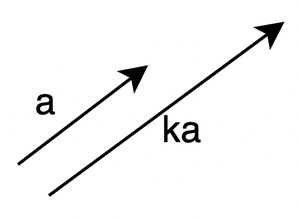
向量的大小将变为,
当 k = -1 时,向量的方向反转,
这称为向量的加法逆。
让我们看一些关于这些概念的示例问题
示例问题
问题 1:从下列量中,找出属于向量的量:
- 重量
- 力量
- 速度
- 高度
回答:
1. Weight does not need directions to be expressed. Hence, it’s a scalar quantity.
2. Force needs the direction to where it must be applied. Thus, it’s a vector quantity.
3. Velocity also has direction. It is also a vector quantity.
4. Height can be simply expressed as a number, there is no need to give direction. Thus, it’s a scalar quantity.
So, Only Force and Velocity are vectors.
问题 2:说明以下陈述是对还是错。
“共线是向量是那些从同一点开始的向量”
回答:
This state is False.
According to the definition mentioned above,
“Two vectors are said to collinear if they are parallel to the same line, irrespective of their magnitudes and direction.”
They need to be parallel to same line. It is not necessary that the vectors which start from same point are parallel to same line.
Figure
问题3:下图显示了四个向量,

根据这个数字说明真假。
 和
和是共线的
 和
和 是共初始向量。
是共初始向量。
回答:
(i) ![]() and
and are collinear
Collinear vectors are parallel to the same line, these vectors are not parallel to each other. They cannot be parallel to the same line. Thus, false.
(ii) ![]() and
and ![]() are co-initial vectors.
are co-initial vectors.
![]() and
and ![]() don’t have the same initial points. Thus are not co-initial vectors.
don’t have the same initial points. Thus are not co-initial vectors.
问题4:用图形表示,40Km位移45°东向北。
解决方案:
The value of the displacement is 40Km. Let’s say this point is represented by Magnitude of this vector is 40Km.
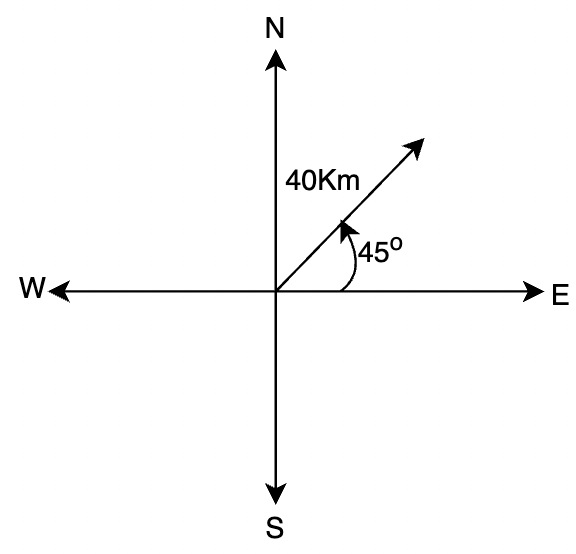
问题5:假设定义了两个向量和
简化和查找
解决方案:
Given,
….(1)
….(2)
Goal is to find
Substituting the values of these vectors from equation (1) and (2)
⇒
⇒
问题 6:对于给定的向量
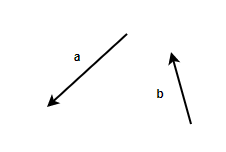
选择以下哪项最能代表

回答:
To add two vectors, b must be translated such that initial point between them becomes the same.

So, the option A represents the closest option to the addition of these two vectors.